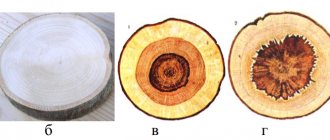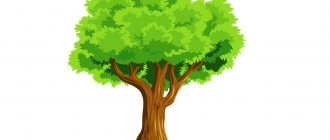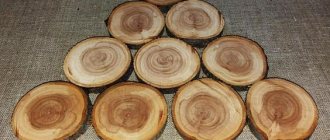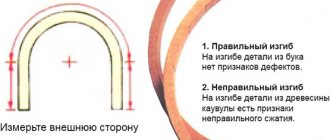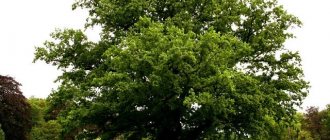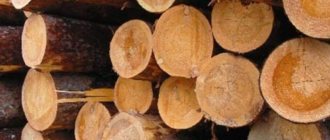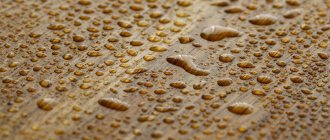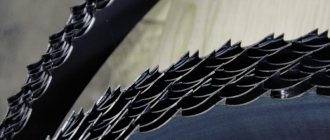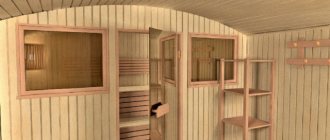Macroscopic structure of wood
The macroscopic structure of a tree trunk is what is visible to the naked eye when cutting a tree or on a diagram.
The following layers are distinguished:
- core;
- sapwood;
- cambium;
- bast;
- cork.
The bark is the most superficial layer. It consists of a superficial crust, a more elastic bast and the lowest layer - the cambium. Strictly speaking, the cambium lies between the bark and the wood, ensuring the growth and supply of nutrients to new tree cells. It is active from spring to autumn, which is when the tree grows.
Under the bark is the main mass of wood. Trees can be sound-bearing (oak, ash) or sound-free (alder). Externally they differ in that the heartwood ones have a clearly visible core that is darker in color, and around it there is a lighter circle called sapwood.
The nucleus is formed from dead cells that are clogged with resin. This is the hardest part of the wood. At the very center of the core is the pith. This is the loosest layer, usually from 2 to 5 mm in circumference.
In kernel-free trees, the density and color of the cut are uniform.
Tree rings mark each year of the plant's life. They vary depending on the age of the tree, growing conditions, etc. Typically, growth rings are two-colored: at the beginning of the year, a softer and lighter layer is formed, and towards the end - a dark, late layer. The early tissue is responsible for transporting nutrients from the roots and back, the late layer performs a protective function.
In addition, nutrients are transported to all parts of the tree using the best (white lines crossing the cut) and vessels (small passages and their accumulations).
Anatomy of a tree
Trees are large woody plants. They have unique properties that allow them to be the dominant species of the plant kingdom in many countries around the world. (arboriculture) based on a deep understanding of the processes of tree growth and development. Only taking this principle into account can you professionally care for trees.
Cells and tissues
All living organisms are characterized by a common organizational structure consisting of cells, tissues and organs. Cells are the main “building blocks” of this structure. In plants, new cells are formed by dividing existing ones. This process takes place in special educational tissues - meristems .
Cells: 1 – Young cell with plasma and nucleus 2 – Cell growth 3 – Mature cell with large vacuole
After cell division, cells undergo a differentiation stage, during which their structure changes and they acquire the ability to perform various specific functions. Cells with similar structure and function are grouped together to form tissues .
Then organs are formed from the tissues, of which plants have six: leaves, trunks, roots, buds, flowers and fruits . And finally, the organs form fully functional organisms - trees.
There are two main types of meristematic tissue:
- primary meristem, from which cells responsible for the growth of shoots and roots in length are formed;
- secondary meristem, from which cells responsible for growth in diameter are formed.
Cross section of a tree trunk: 1 – Core 2 – Core 3 – Core ray 4 – Sapwood 5 – Cambium 6 – Phloem 7 – Phellogen 8 – Bark
Trees have two secondary meristems: the cambium and phellogen.
- The cambium plays an extremely important role: during the process of division, new cells are formed in it, forming the vascular system of the tree. It generates two types of tissue: xylem on the inside and phloem on the outside.
- Phellogen is the cambium from which the bark is formed. Xylem is a part of wood consisting of dead and living cells. Dead cells include tracheae and tracheids in coniferous trees and vessels in deciduous trees. Xylem performs three functions: it serves as a mechanical support for the tree; ensures the movement of water and minerals; provides storage of nutrients.
When a tree is cut down and viewed in cross section, growth rings are visible in the xylem. In temperate zones, these rings correspond to the annual formation of xylem in the cambium. They are circular in shape because the relative size and density of the vascular tissue changes during the growing season. As the growing season approaches the end, the cells become smaller in diameter.
Thus, due to the sharp difference between cells formed early in the season (earlywood) and cells formed later (latewood) , individual annual growth becomes distinguishable.
Core ray in wood 1. Ring-vascular wood2. Disseminated vascular wood
In terms of wood, coniferous and deciduous species differ significantly from each other. In addition, among deciduous trees, ring-vascular species (for example, Oak (Quercus), Ash (Fraxinus)) and scatter-vascular species (for example, Linden (Tilia), Beech (Fagus)) are distinguished.
Heartwood forms in the center of the trunk It is surrounded by living sapwood . Not all conducting elements of xylem serve to move water. Only the living and active sapwood tissue is responsible for this, while the other part of the xylem, located closer to the center, is non-functional. These dead cells form the core, a non-conductive tissue that is darker in color than the sapwood.
Phloem is responsible for moving sugar from leaves to other parts of the plant. In addition to phloem and xylem, the vascular system of a tree includes ray cells . The rays diverge radially from the center of the cross section through the phloem and xylem and serve to transport sugars and their components along the trunk. They help limit the spread of rot through wood tissue and store nutrients in the form of starch.
Transverse section of the trunk
The outer part of the branches and trunk of trees is called bark . This is a protective fabric that maintains the temperature of the inside of the trunk, protects plants from damage and reduces water loss. The bark consists of nonfunctional phloem, cork tissue, and dead cells. To minimize water loss, its cells are impregnated with wax and oils.
Gas exchange between living tree tissue and the atmosphere occurs through lenticels , small pores in the bark.
This is interesting
The bark of different trees has different structures and properties. For example, beech bark is very smooth with a small amount of cork tissue, while oak bark, on the contrary, forms thick layers of phellem.
| See also: |
Microscopic structure of wood
The microscopic structure of a tree trunk looks at the cellular structure of the plant. Tree tissue cells are similar in structure to the rest (core, protoplast, shell), but due to the fact that the shell consists of dense carbohydrates (cellulose) and lignin, it becomes strong and rigid. In terms of strength, wood is compared to reinforced concrete.
Tree cells vary in structure and function. Highlight:
- mechanical cells that perform a supporting function;
- conductive (transmitting nutrients and microelements);
- storage (responsible for the storage of substances and growth of wood mass).
Wood source
The main component of a tree trunk is “wood” or “wood tissue”. This is a generalized name for the substance located under the shell of a tree - bark. Wood is an element of the plant's conductive system. The structure of the wood of the stem includes the following elements:
- Bark is the protective outer layer of a tree, protects the trunk from mechanical, physical, thermal and other influences, and also prevents the penetration of infection and viral diseases.
- Phloem is the subcrustal layer, which is necessary for circulation and supplying the remaining layers with useful minerals and sugars.
- Cambium is the thinnest layer that forms the young cells of the stem.
- Tree rings – separate each part or layer of the trunk. Differs from the previous layer in a darker or lighter color.
- It is formed by the cambium (over the course of a year) during the natural development process of the tree during its growth. Consists of soft and hard layers. The color of the hard layer is much darker, which allows scientists to tentatively determine the age of the plant.
- Sapwood is the water-conducting part of the trunk; its distinctive feature is its light color.
- The core - occupies the largest area of the trunk. Consists of old layers and is the strongest part.
- All tree species have “core rays” - narrow strips up to 1 mm thick, converging towards the core. The medullary rays are necessary to provide the entire trunk with nutrients.
- The core is the center of the trunk, which is surrounded by annual rings. It is harder than the core, but at the same time it is the most fragile part of the tree, which is also often susceptible to fungal diseases.
Chemical composition of wood and bark
The chemical elements of wood are located in cell membranes. Are divided into:
- organic;
- mineral.
Minerals occupy no more than 1% of the composition and remain after the wood is burned. These are salts of sodium, potassium, iron and other minerals.
Organic substances are divided into structural components that form the basis of cells: cellulose, lignin.
Components that are not part of the cell can be extracted from wood by extraction: essential oils, tannins, dyes.
The chemical composition can change even within the same species, depending on the location of the tree, the composition of the soil, and the age of the plant.
Elementary composition of organic substances:
- carbon;
- oxygen;
- hydrogen;
- nitrogen.
Performance characteristics
Wood processing primarily implies its further use. Currently processing is carried out:
- Mechanically: sawing, milling, planing, boring, etc.
- Chemical-mechanical method - preparation of materials with residues after mechanical processing.
- Chemical processing - decomposition and shaping using chemicals.
However, the choice of processing and further application directly depends on the structural features of the wood and is carried out taking into account indicators such as:
- Hardness is the lifespan of wood fiber.
- Shrinkage – compatibility of different types of wood.
- Oxidation is the degree of influence of the external environment.
- The expressiveness of the drawing is necessary for visual perception.
- Resistance to loads.
Attempts to artificially create a wood substitute that fully possesses all its qualities have not yet been crowned with success.
And although the newest materials have been able (with the help of various types of chemical compounds) to be endowed with certain advantages inherent in wood, they are still an order of magnitude inferior to the original.
Wood defects
If the structure of the tree or tissues is damaged, or defects are observed that reduce the quality of the wood, then they speak of its defects.
The quality of wood is determined by GOST 2140-81.
The description of defects includes such signs as:
- knots;
- cracks;
- curvatures and imperfections in the shape of the trunk;
- foreign (chemical) coloring;
- wood defects;
- fungal diseases;
- foreign inclusions, etc.
Defects can be more or less significant depending on the purposes for which the wood is used, as well as on the possibility of eliminating them.
Properties of wood
Among the qualities possessed by the internal structure of the stem of a certain type of wood, attention is most often paid to:
- Physical - among which we should highlight: Density - the ratio of mass to volume.
- Humidity – divided into: hygroscopicity – absorption of moisture from the environment;
- water absorption - absorption of liquid;
- porosity - the percentage of pores in the total volume of wood;
- swelling - an increase in volume under the influence of moisture;
- shrinkage - reduction in size during drying
- warping is a change in the shape of wood under the influence of moisture.
- Strength – resistance to the destructive effects of mechanical loads. It has its own classification and is divided according to the direction of load application (longitudinal, transverse, bending).
Advantages of use in construction
The structural features of coniferous trees have made them a popular material for the construction of country houses, cottages, bathhouses, outbuildings and more. Wood has several advantages:
- High density and strength. This provides the lumber with good load-bearing capacity.
- Resistant to rotting, mold and mildew. This is due to the high resin content in the composition: the substance prevents the proliferation of dangerous microorganisms.
- The trunk is straight and even in shape, it can have a long length. Pine reaches 40 meters in height, spruce can grow up to 50 meters. This expands the possibilities for producing various lumber.
- Easy to process most softwoods. They are used in the manufacture of various types of timber, rounded logs and more.
Coniferous species are widespread in Russia, so the wood has a relatively low cost. It has become a popular building material for the construction of a wide variety of buildings. Thanks to the characteristics of wood, houses made from it can last up to 100 years or more.
Main cuts
The main sections are shown in the figure below. They have different properties and structure.
The main cuts of a tree trunk: 1 - transverse (end), 2 - radial, 3 - tangential
Cross section
A cut perpendicular to the axis of the trunk and the direction of the fibers forms the end, or, as it is called, the transverse secant plane of the trunk. the structure of the wood is clearly visible , namely concentric annual rings , pith, medullary rays, bark section and bast. The cross section is shown in the figure:
Radial section
A cut passing through the middle of the trunk along the direction of the wood grain forms a radial secant plane. With this section, the growth rings are also visible, but not in the form of concentric rings, but in the form of parallel stripes.
Tangential cut
The tangential cut, like the radial one, is directed along the fibers, but does not pass through the axis of the trunk, but at some distance from it. In other words, this section is constructed along the chord of the cross section. In a tangential section, the growth rings have the appearance of elongated parabolas, since the trunk with the growth rings narrows upward.
